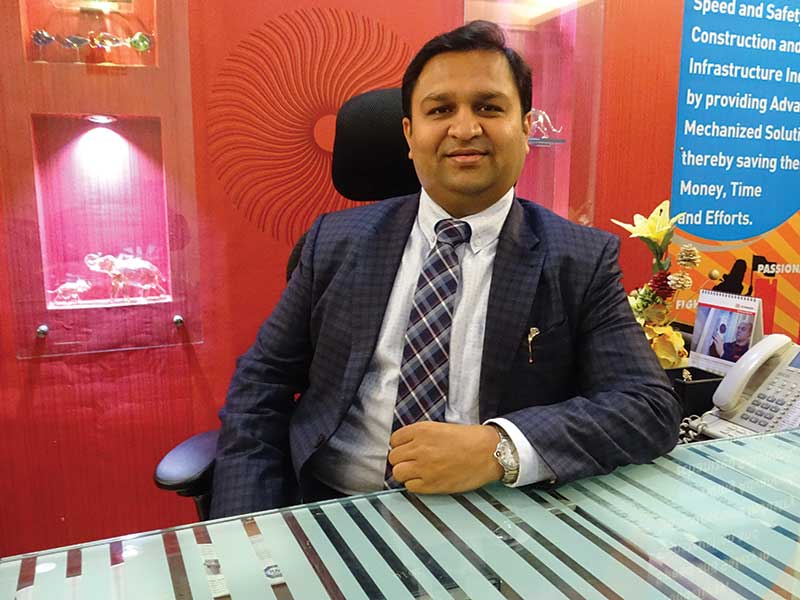What are the building codes and bylaws regarding safety in high rises?
The National Building Code of India covers detailed guidelines for construction, maintenance, and fire safety of structures. Guidelines were issued to the States to incorporate the recommendations of the National Building Code into their local building bylaws, making the recommendations a mandatory requirement. The advisory has been issued to all the State Governments to incorporate and implement the latest National Building Code of India 2016 Part – IV “Fire & Life Safety” in their building bylaws.
What does a Fire Evacuation System comprise?
Fire Exit Staircase (for building above 15m height) and Fire Evacuation lift are the 2 systems of evacuation included in the norms (for buildings above 70m height). The fire exit staircase is basically a separate staircase lobby connected to the common lobby, which has access at every floor and is protected with a fire-rated door (FRD). Since it is a manual evacuation, it becomes quite challenging to evacuate senior citizens, handicapped persons, pregnant women, and small children.
What are the features in a Fire Fighting Lift and an Evacuation Lift?
Fire–Fighting Lift or Fire Lift is used to transport passengers during a fire and by the firemen to access the fire affected floor. This lift has special features like a firemen switch, a fire rated landing door, and firemen mode which disables all landing calling buttons. With the use of the firemen mode, the firemen inside the cabin can take full control of the lift.
However, the fire lift has some limitations when it comes to mass evacuation. In the event of an emergency, there is no trap door in a fire lift. The cabin is made of an ordinary sheet metal panel, which cannot withstand fire. Due to the lack of a vision panel on the car and the landing floor in the fire lift, the firemen cannot see the floor condition from the lift car and must step out. Since they are usually unaware of the intensity of smoke on the floor, they suffer fatigue.
On the other hand, the Fire Evacuation Lift is specially designed to evacuate people on time in case of fire. The firemen can also use this lift to access the fire affected floor as it has a firemen mode, besides many special features which protect passengers from fire and smoke during the evacuation process as the cabin is made of non-combustible material, and all the side enclosed panels are filled with ceramic wool with a 2-hour fire rating sandwich type construction that resists the heat.
The landing and car door in a fire evacuation lift have a 2-hour fire-rated vision panel, which helps the firemen avoid fatigue. This means that the firemen and the passengers can see the smoke density in the floor before opening the door. A two-way communication system enables a person standing on any floor to communicate with the lift operator during an emergency.
An in-built 30-minute battery back-up and an additional manual changeover switch with socket to connect to the external DG ensures continuous power supply to the lift in a fire emergency situation. Unlike other lifts and fire safety equipment, the fire evacuation lift is safer and faster for evacuating the elderly, people with disabilities, children, and pets.
The fire evacuation lift is an advanced, technically fulfilled equipment to rely on in fire accidents. It has an IoT (Internet of Things)-based control panel that allows automatic notifications to the nearest fire department in the event of a fire. It also has features that allow the user and original equipment manufacturer (OEM) to access real-time data such as total operating hours, day-by-day operating hours, fault history, and so on. Everyone, from the users to the fire department, is alerted by this simple communication process. A fire evacuation lift can save 100 people in around 30 minutes – the reason why it is a lifesaving solution in a fire emergency in the truest sense.
The fire evacuation lift is also called the vertical fire brigade or PPE (public protective equipment) due to the multiple roles it plays. The Lift is located at mid-landing / landing opening at every floor in a fire and smoke protected lobby which consists of an electrically operated vertical transport system (Lift) with special features like 2-hour fire rated landing and cabin doors with vision panel, in build battery back-up, high speed traction machine, audio communication system etc.
In the event of a fire, what immediate procedures need to be followed by the building authorities to evacuate residents safely?
The Passenger Lift is not meant for fire rescue operations; it is designed to transport people in normal conditions and does not have any fire safety features like firemen mode or a fire rated door. Hence, it is not recommended to use a passenger lift in case of a fire in the building
Once the fire emergency is confirmed by the building authorities, the fire alarm should be activated to warn the occupants, and immediately inform the nearest fire station and hospital. The PA (public announcement system) should be activated to guide people for safe evacuation.
Trained voluntaries from building authorities should be in action to evacuate people through the evacuation lift and fire exit staircase lobby and guide them to an assembly area or refuge floor.
More than the fire, it’s the dense smoke that traps the people. Please elaborate on solutions like smoke vents, etc.
All smoke is toxic and poses a serious threat to the health of building occupants and firefighters. As such, their protection should be the utmost priority. A relatively small fire inside a building will also generate a lot of smoke, even when limited to the object of origin, this smoke can easily spread beyond its place of origin if protective measures are not in place. In fact, smoke management is key to limiting the damage of a fire.
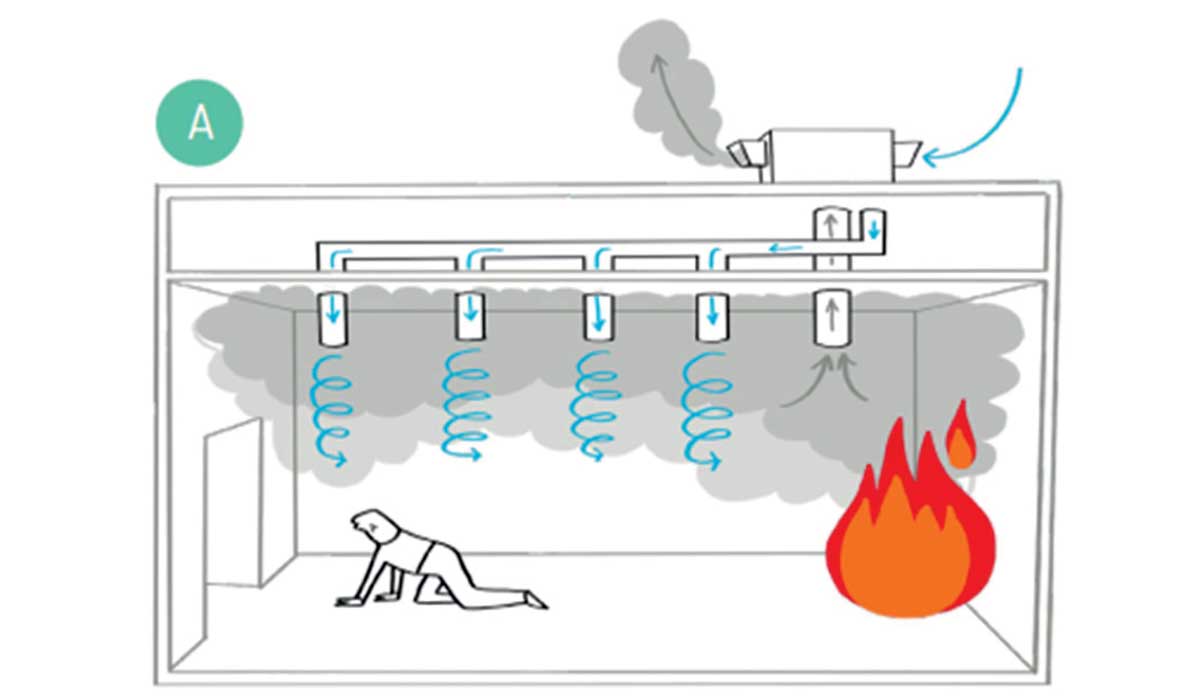
Dilution of the smoke occurs following the introduction of air streams that extend the smoke to the upper areas of the room. The smoke rises and permits occupants to evacuate.
Time is of the essence when fighting fires. A few seconds can be all that stands between controllable flames and an out-of-control blaze. Therefore, Fire Evacuation Lifts are important to evacuate the people on time before it gets out of control. It will be a lifesaver for fire fighters and for the people.
Dr Vikram Mehta
Time to Get Fire Evacuation Systems in place for High-Rise Buildings
Incidences of fire breakouts are rising, raising questions over fire safety of high-rises. The Mumbai Fire Brigade recently stated that the city has witnessed more than 48,434 small and major fires during 2008 to 2018, of which 1,568 were reported in Mumbai’s high-rises; and sabotaging 8,737 residential buildings and about 3,833 commercial buildings.
The lack of awareness, negligence towards fire safety audits, non-implementation of fire safety rules by the buildings, or technical reasons like non-functional internal firefighting systems, inadequate sprinkler arrangements, etc., could be the reasons why fire accidents are happening.
It is observed that many buildings in Mumbai do not have a Fire Evacuation System in place. Timely evacuation can help prevent loss of assets and save lives of the occupants. The Municipal Corporation of Greater Mumbai (MCGM) and the Fire Brigade Department realized the need to equip high-rise buildings with the right kind of Fire Evacuation System, which, in 2018, made it mandatory for all buildings with a height above 70 meters (around 22 floors) to have provision for a Fire Evacuation Lift.
Under the fire safety requirements, protective fire equipment like fire evacuation lifts, fire sprinklers, and other fire management devices will make the dangerous job of fire- fighting safer. It is also imperative for all cities to ensure that safer buildings are designed and constructed.
Layering of the smoke consists of a low impulse air supply in the lower section of the room that clears the lower part of the room, allowing occupants to escape. The dimension of the extraction system must be adjusted to the typology and size of the room to clear the smoke efficiently.
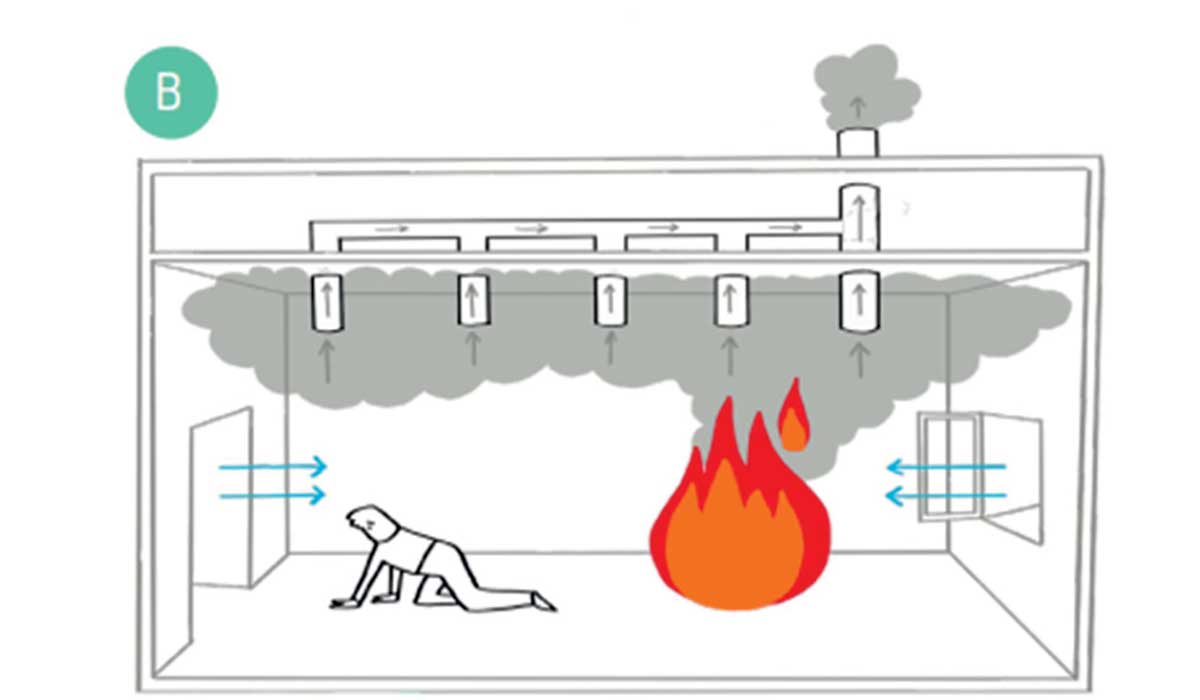
Pressure Differential System (PDS) is a method designed to prevent the inflow of smoke in dedicated areas (such as evacuation routes, stairs cases, etc). It consists of activating fans that create an excess of pressure (over pressure) that will contain the smoke from spreading. This system takes into account the variation of pressure caused by the opening and closing of fire doors, the evolution of temperature from fire, the air density, as well as structural leakages in walls, doors, roofs, etc.
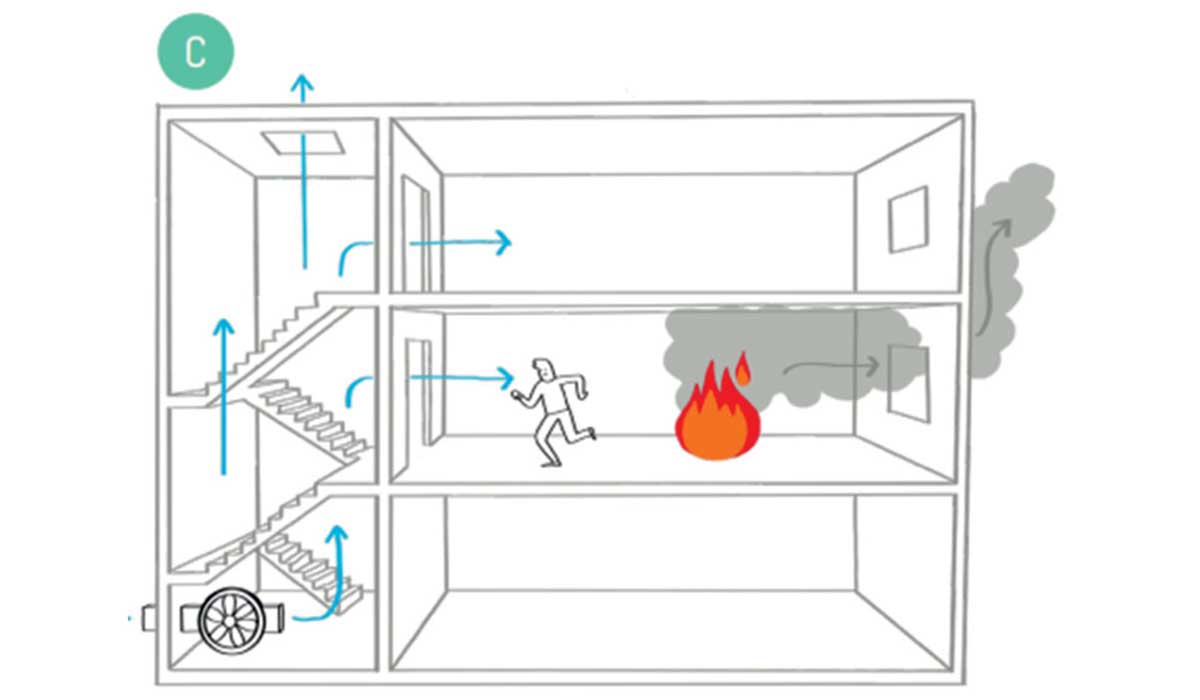
Smoke compartmentation: In many cases, it is useful to divide fire compartments into smoke compartments. Smoke compartmentation aims at compacting and containing smoke in a dedicated area, thereby limiting the spread of smoke.
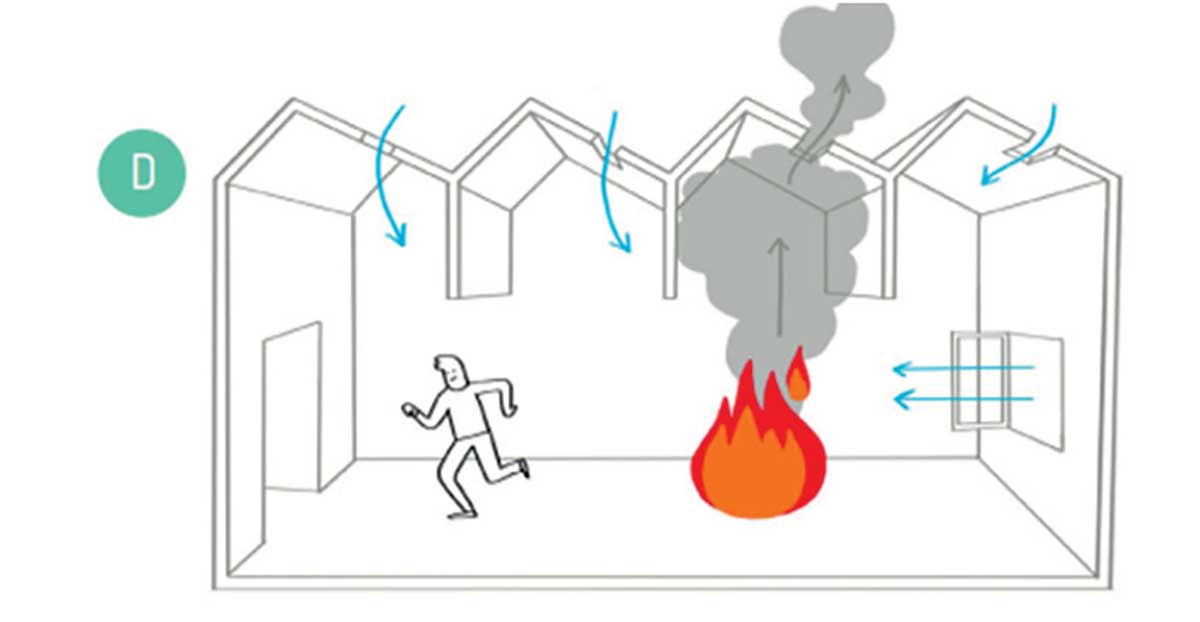
The Fire Evacuation Lift has an opening at the smoke check lobby that protects people from smoke as well and lift shaft and lift.
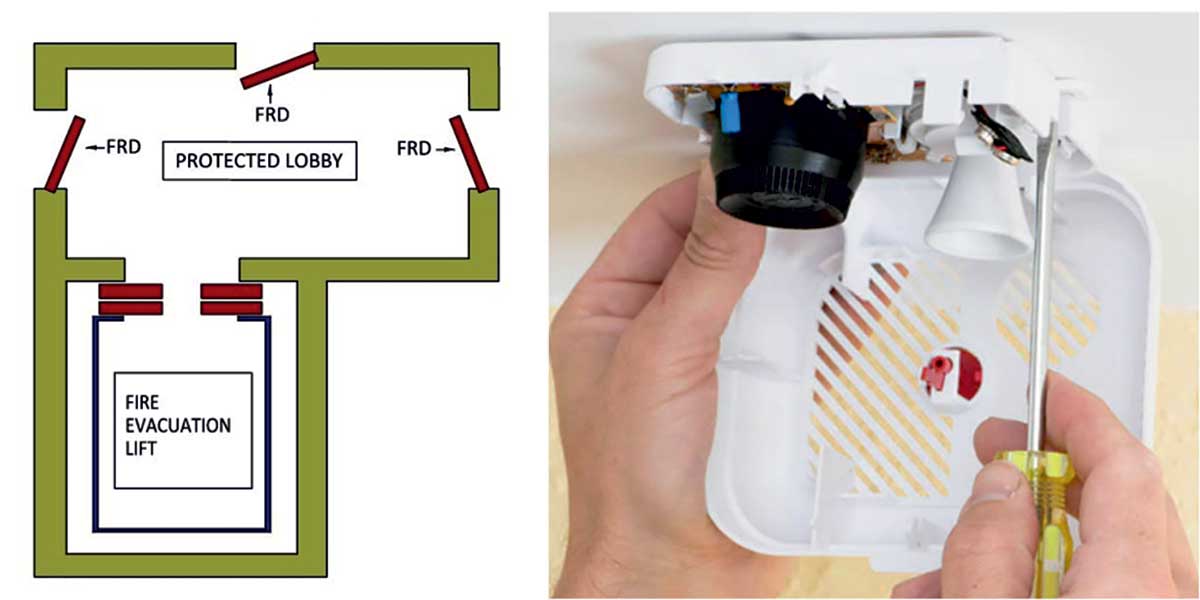
One of the most effective ways to reduce the effects of smoke inhalation is to limit exposure through early detection.
Modern Buildings have fixed glass windows that do not open or break easily. What suggestions would you like to give architects and developers to make high rise buildings safer?
Modern buildings with glass windows / facade look aesthetic but fire safety is equally important and must be taken into account while designing them. The openable windows should have glass which is non-laminated. Fully tempered glass (monolithic or insulated) should be used in these panels so that it can be easily broken with a sharp object, if necessary.

